
The Oberhof bobsleigh, luge, and skeleton track is a venue used for bobsled, luge and skeleton located in Oberhof, Germany.

The Oberhof bobsleigh, luge, and skeleton track is a venue used for bobsled, luge and skeleton located in Oberhof, Germany.
Oberhof had been the home of sledding activities since 1905, mostly bobsleigh. [1] In 1931, the facility hosted the first ever FIBT World Championships in the two-man bobsleigh event won by the two-man German team of Hanns Killian and Sebastian Huber. [2] After World War II, Oberhof was partitioned into East Germany. Following the successes of the East Germans at the FIL World Luge Championships during the 1960s with Thomas Köhler (men's singles world champion in 1962 and 1967, men's doubles world champion in 1965 and 1967), Ilse Geisler (women's singles world champion in 1962 and 1963), Ortrun Enderlein (women's singles world champion in 1965 and 1967), Petra Tierlich (women's singles world champion in 1969, Wolfgang Scheidel (men's doubles world champion in 1965), and Klaus Bonsack (men's doubles world champion in 1967), the East German government decided it was time to construct a permanent, artificially refrigerated reinforced concrete track for year-round training and usage. [3] [4] [5] In 1966, East Germany was awarded the FIL World Luge Championships in Friedrichroda (misspelled as Friedrichsroda), but the event was cancelled. [6] The success of the first permanent bobsleigh, luge, and skeleton track in Königssee, West Germany, completed in 1968 and first used for the world luge championships the following year, also played a factor. [7] [8] In 1969, it was decided to construct a permanent facility in Oberhof. [9] The track was completed in 1971 with a World Cup test taking place the following year. [9] Since then the track has hosted World Cup events, mostly in luge though it has hosted events in bobsleigh (1974 in two-man) and skeleton (1993). [9]
Oberhof has undergone four track renovations, the first in 1996 where it was closed from April to October for a total reconstruction, a second in 2002 when a new ammonia refrigeration system was installed and turn 14 was modified for safety reasons, and a third in 2006 when new start houses were built for both men and women, and turn 7's profile was modified for safety reasons. [9] The cost of the 2016 renovation was €4 million. [10] The track was again renovated in 2020 with improvements to the roof [11] as well as redesign of many of the track curves and improvements to the starts and start houses. [12]
Overall track length is 1354.5 meters. [13] The venue includes a vertical drop of 96.37 meters from start to finish.
| Sport | Length (meters) | Turns |
|---|---|---|
| Men's singles luge, men's skeleton, two-man bobsleigh [14] | 1069.70 | 14 |
| Women's luge and skeleton - women's singles and men's doubles [14] | 945.60 | 11 |
| Junior's luge and skeleton | 665.40 | 7 |
The only named curves are the "S-Kombination" (German for "S Combination") which are turns eight through eleven and the "Zielkurve" (German for "Finish Curve") is turn fourteen, a Kreisel (or circular) curve. [13] [14]
| Sport | Record | Nation - athlete(s) | Date | Time (seconds) |
|---|---|---|---|---|
| Bobsleigh two-man [14] | Track | 1988 | 44.62 | |
| Luge - men's singles [15] | Start | David Möller - | 27 January 2008 | 8.199 |
| Luge - men's singles [15] | Track | Felix Loch - | 27 January 2008 | 44.996 |
| Luge - women's singles [16] | Start | Natalie Geisenberger - | 25 January 2008 | 7.995 |
| Luge - women's singles [16] | Track | Tatjana Hüfner - | 16 January 2010 | 42.920 |
| Luge - men's doubles [17] | Start | 16 January 2010 | 7.755 | |
| Luge - men's doubles [17] | Track | 16 January 2010 | 42.717 |
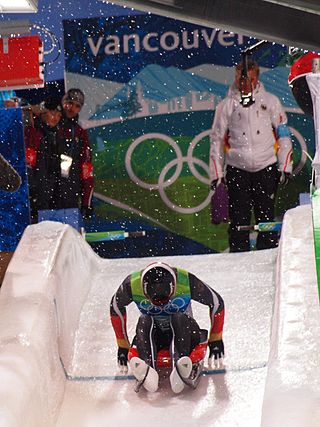
A luge is a small one- or two-person sled on which one sleds supine (face-up) and feet-first. A luger begins seated, propelling themselves initially from handles on either side of the start ramp, then steers by using the calf muscles to flex the sled's runners or by exerting opposite shoulder pressure to the pod. Racing sleds weigh 21–25 kg (46–55 lb) for singles and 25–30 kg (55–66 lb) for doubles. Luge is also the name of an Olympic sport that employs that sled and technique.
The FIL World Luge Championships, part of the International Luge Federation (FIL) have taken place on an almost annual basis in non-Winter Olympics years since 1955. These championships are shown for artificial tracks. See FIL World Luge Natural Track Championships for all natural track events that have taken place since 1979.
The FIL European Luge Championships, part of the International Luge Federation (FIL) have taken place since 1914. From 1914 to 1934, these championships were part of the Internationaler Schlittensportsverband. From 1935 to 1956, the championships were held under the auspices of the Fédération Internationale de Bobsleigh et de Tobogganing. Since 1962, the event has been under the auspices of the FIL and has been held in even-numbered years since 1980. Since 2012, it is held annually within a preselected World Cup stages in the so-called race-in-race mode. The results of non-European athletes at these World Cup stages are not counted for European Championships standings.

The International Luge Federation is the main international federation for all luge sports. Founded by 13 nations at Davos, Switzerland in 1957, it has members of 53 national luge associations as of 2009 and is based in Berchtesgaden, Germany. In reaction to the 2022 Russian invasion of Ukraine, in March 2022 the FIL banned all Russian athletes, coaches, and officials from its events, suspended all Russian officials appointed to its Commissions and Working Groups, and deemed Russia ineligible to host any of its events.

The FIL World Luge Championships 2008 took place January 21-27, 2008 at the bobsleigh, luge, and skeleton track in Oberhof, Germany for the third time after having hosted the event in 1973 and 1985. The relay competition took the place of the team event that had been held at every world championship since 1989. This event had all of teams start at the same part of the track, then run down to the finish and tap on a relay marker to exchange from one slider on a team to the next with the fastest time winning.

The Altenberg bobsleigh, luge, and skeleton track is a venue in Germany for bobsleigh, luge, and skeleton. Located in Saxony in eastern Germany, it is northwest of Altenberg, near the border with the Czech Republic.

The Königssee bobsleigh, luge, and skeleton track is a venue in Germany for bobsleigh, luge and skeleton, located in Schönau am Königssee, Bavaria, near Königssee and the border with Austria. Completed 56 years ago in 1968, it is the first permanent, artificially refrigerated bobsleigh, luge, and skeleton track in the world. In July 2021, the track was severely damaged by the floods that affected the European continent, and is currently under reconstruction.
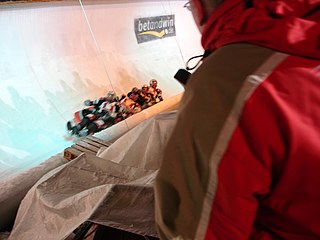
The Olympic Sliding Centre Innsbruck is a venue for bobsleigh, luge and skeleton located in Igls, Austria. The most recent version of the track was completed in 1975 and is the first permanent, combination artificially refrigerated bobsleigh, luge, and skeleton track, serving as a model for other tracks of its kind worldwide. It hosted the bobsleigh, luge, and skeleton competitions for the 2012 Winter Youth Olympics.

The Mt. Van Hoevenberg Olympic Bobsled Run is a venue for bobsleigh, luge and skeleton in the United States, located at the Lake Placid Olympic Sports Complex in Lake Placid, New York. This venue was used for the 1932 and 1980 Winter Olympics and for the only winter Goodwill Games in 2000. The track hosted both the first FIBT World Championships and FIL World Luge Championships held outside of Europe, doing so in 1949 and 1983. The third and most recent version of the track was completed in 2000. In 2010 the bobsled track was listed on the National Register of Historic Places.
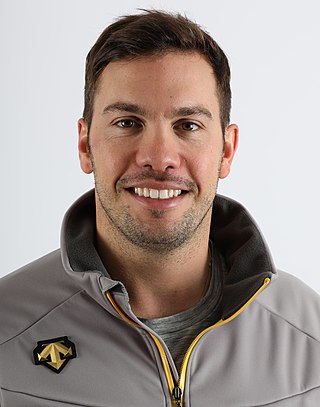
Tobias Wendl is a German luger who has competed since 1993, acting as a front. He won a silver medal in the men's doubles event at the 2008 FIL World Luge Championships in Oberhof, Germany, a silver and a bronze at the FIL European Luge Championships 2010 in Sigulda, a gold at the FIL World Luge Championships 2013, and two gold medals at his debut Winter Olympics at the 2014 Winter Olympics in Sochi. He is also a Master Sergeant in the German Army.

The Sigulda Bobsleigh and Luge Track is located in Sigulda, Latvia, built in 1986. Currently, the track manager is Dainis Dukurs, former bobsleigh brakeman and the father of skeleton racers Martins and Tomass Dukurs.

The Canada Olympic Park bobsleigh, luge, and skeleton track is a bobsleigh, luge, and skeleton track located in Calgary, Alberta. Part of Canada Olympic Park, it hosted the bobsleigh and luge competitions at the 1988 Winter Olympics. This track is one of only two of its type in the world to be featured in a non-documentary film when it was part of the 1993 American film Cool Runnings which loosely followed the Jamaican Bobsled Team during their competition in bobsleigh at the 1988 Games.

The Whistler Sliding Centre is a Canadian bobsleigh, luge, and skeleton track located in Whistler, British Columbia, that is 125 km (78 mi) north of Vancouver. The centre is part of the Whistler Blackcomb resort, which comprises two ski mountains separated by Fitzsimmons Creek. Located on the lowermost slope of the northern mountain, Whistler Sliding Centre hosted the bobsleigh, luge, and skeleton competitions for the 2010 Winter Olympics.
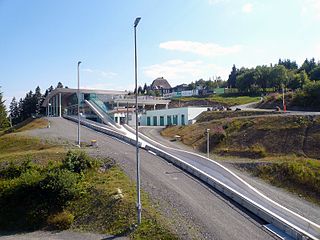
The Winterberg bobsleigh, luge, and skeleton track is a bobsleigh, luge, and skeleton track located in Winterberg, Germany. It is the only track of its kind in the world with a turn that has corporate sponsorship with turn seven being sponsored by Veltins, a German brewery which has its headquarters located in neighboring Meschede.

The Paramonovo bobsleigh, luge, and skeleton track is a bobsleigh, luge, and skeleton located in Paramonovo, Russia, 60 kilometers (37 mi) outside of Moscow.

Sascha Benecken is a German luger who has competed since 1999. With his doubles partner Toni Eggert he has been world champion ten times and won the overall World Cup six times.

Julia Taubitz is a German luger.

The 2019 FIL European Luge Championships took place under the auspices of the International Luge Federation at the Oberhof bobsleigh, luge, and skeleton track in Oberhof, Germany from 9 to 10 February 2019.

Anna Berreiter is a German luger. She is the 2023 World and European Champion and silver medallist at the 2022 Winter Olympics. A two-time Under-23 World Champion, Berreiter was also part of the German squad that took the World team relay title in 2023 and has won further 1 silver and 1 bronze medals in sprint discipline at the World Championships level. She is the youngest woman to win a Luge World Cup race, and so far, has won 4 individual races in her World Cup career.
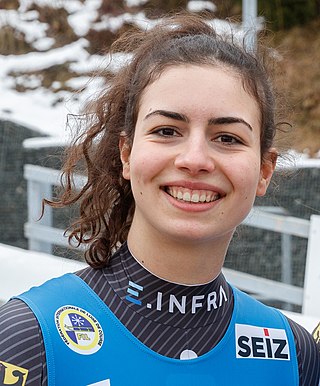
Jessica Doreen Degenhardt is a German luger. She is four-time Junior World Champion and won gold medal at the 2020 Winter Youth Olympics at doubles' race and silver medal at the individual race. She also retains the World Championships gold medal at 2022, 2023 in women's doubles discipline and Women's doubles' sprint discipline in 2023.